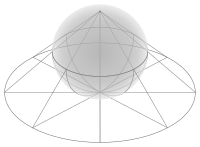Complex projective space

Okay kiddo, let's imagine you have a bunch of fancy shapes that you like to play with, like triangles, squares, and circles. But sometimes, when you look at these shapes, you realize that they need a little bit of help to look right. They might be missing a point or two or they might overlap each other in a weird way.
In math, we have a way to fix these problems called "projecting." We take these shapes and push them onto a flat surface like a piece of paper, to make them look right. This process is called projection.
Now, sometimes we have shapes that can't be fixed by projecting onto a flat surface. These shapes are special and need to be projected onto something called a "complex projective space."
Imagine a big ball, like a beach ball or a globe. The outside of this ball is called a "sphere." Now, let's imagine drawing all our shapes on the inside of this sphere. But since the sphere is 3D, we need to add a point at the very top, called the "north pole." This point helps us visualize our shapes better when they are all nestled inside the sphere.
But wait, there's more. Inside our sphere, we can't have shapes overlap each other or have weird spaces in between them. So we need to add another point, this time at the bottom of the sphere, called the "south pole." This helps us eliminate any weird overlaps or gaps between our shapes.
This sphere, with the north and south pole, is our complex projective space. We can now project all our shapes onto this space and they will look just right.
So, to sum it up, complex projective space is like a big ball with a north and south pole, that we use to project our shapes onto when they can't be fixed on a regular flat surface. It helps us make our shapes look just right and eliminates any weird overlaps or gaps.
In math, we have a way to fix these problems called "projecting." We take these shapes and push them onto a flat surface like a piece of paper, to make them look right. This process is called projection.
Now, sometimes we have shapes that can't be fixed by projecting onto a flat surface. These shapes are special and need to be projected onto something called a "complex projective space."
Imagine a big ball, like a beach ball or a globe. The outside of this ball is called a "sphere." Now, let's imagine drawing all our shapes on the inside of this sphere. But since the sphere is 3D, we need to add a point at the very top, called the "north pole." This point helps us visualize our shapes better when they are all nestled inside the sphere.
But wait, there's more. Inside our sphere, we can't have shapes overlap each other or have weird spaces in between them. So we need to add another point, this time at the bottom of the sphere, called the "south pole." This helps us eliminate any weird overlaps or gaps between our shapes.
This sphere, with the north and south pole, is our complex projective space. We can now project all our shapes onto this space and they will look just right.
So, to sum it up, complex projective space is like a big ball with a north and south pole, that we use to project our shapes onto when they can't be fixed on a regular flat surface. It helps us make our shapes look just right and eliminates any weird overlaps or gaps.
Related topics others have asked about:
